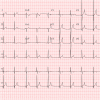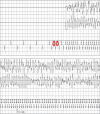Red herring pathogenic variants: a case report of premature ventricular contraction-triggered ventricular fibrillation with an incidental pathogenic LMNA variant
- PMID: 35528128
- PMCID: PMC9071339
- DOI: 10.1093/ehjcr/ytac115
Red herring pathogenic variants: a case report of premature ventricular contraction-triggered ventricular fibrillation with an incidental pathogenic LMNA variant
Abstract
Background: Pathogenic variants in the lamin A/C gene (LMNA) can lead to a wide range of phenotypes from dilated and arrhythmogenic cardiomyopathies and conduction abnormalities to partial lipodystrophies. This case highlights a coincidental pathogenic LMNA variant identified in a patient with sudden cardiac arrest (SCA). We demonstrate the need for careful interpretation of pathogenic variants identified in cardiomyopathy genes by highlighting a case in which a coincidental pathogenic LMNA variant was found in a patient with premature ventricular complex (PVC)-induced ventricular fibrillation (VF).
Case summary: We present the case of a 16-year-old male with SCA secondary to VF. Genetic testing identified a maternally inherited pathogenic variant in LMNA annotated c.1961dup; p.T655Nfs*49. The patient received an implantable cardiac defibrillator and was discharged on nadolol. The patient's two brothers were also variant-positive. However, the patient and both brothers had normal chamber dimensions on echocardiogram and no late gadolinium enhancement on cardiac magnetic resonance imaging. The family members with the variant were recommended to have prophylactic implantable cardiac defibrillators and thus sought a second opinion. The patient received an appropriate shock and device interrogation identified PVCs. Electrophysiology study identified PVC-induced VF which was ablated with no recurrent ventricular arrhythmias/implantable cardioverter defibrillator therapies over 8 months of follow-up. Although the variant in LMNA could lead to cardiac arrest, the clinical phenotype was consistent with a non-genetic aetiology. The family members were told to have periodic cardiac evaluation.
Discussion: This case demonstrates the identification of a coincidental pathogenic variant in a cardiomyopathy gene in a patient with cardiac arrest. Although this variant could lead to cardiomyopathy, it appears the cardiac arrest was not due to the pathogenic variant. This highlights the need to consider the clinical phenotype when interpreting genetic test results for cardiomyopathies even in the presence of a positive genetic test result.
Keywords: Cardiomyopathy; Case report; Cryogenic ablation; Genetic testing; LMNA; Lamin A/C.
© The Author(s) 2022. Published by Oxford University Press on behalf of European Society of Cardiology.
Figures







Similar articles
-
LMNA-Related Dilated Cardiomyopathy.2008 Jun 12 [updated 2022 Mar 17]. In: Adam MP, Feldman J, Mirzaa GM, Pagon RA, Wallace SE, Amemiya A, editors. GeneReviews® [Internet]. Seattle (WA): University of Washington, Seattle; 1993–2025. 2008 Jun 12 [updated 2022 Mar 17]. In: Adam MP, Feldman J, Mirzaa GM, Pagon RA, Wallace SE, Amemiya A, editors. GeneReviews® [Internet]. Seattle (WA): University of Washington, Seattle; 1993–2025. PMID: 20301717 Free Books & Documents. Review.
-
Implantable cardioverter-defibrillators in lamin A/C mutation carriers with cardiac conduction disorders.Heart Rhythm. 2013 Oct;10(10):1492-8. doi: 10.1016/j.hrthm.2013.06.020. Epub 2013 Jun 26. Heart Rhythm. 2013. PMID: 23811080
-
Pregnancy and Progression of Cardiomyopathy in Women With LMNA Genotype-Positive.J Am Heart Assoc. 2022 Apr 19;11(8):e024960. doi: 10.1161/JAHA.121.024960. Epub 2022 Apr 18. J Am Heart Assoc. 2022. PMID: 35434999 Free PMC article.
-
Clinical and functional characterization of a novel mutation in lamin a/c gene in a multigenerational family with arrhythmogenic cardiac laminopathy.PLoS One. 2015 Apr 2;10(4):e0121723. doi: 10.1371/journal.pone.0121723. eCollection 2015. PLoS One. 2015. PMID: 25837155 Free PMC article.
-
Genotype-phenotype correlation of LMNA variants involving the Arg541 residue: a case report with multimodality imaging and literature review.ESC Heart Fail. 2020 Oct;7(5):3169-3173. doi: 10.1002/ehf2.12776. Epub 2020 Jul 15. ESC Heart Fail. 2020. PMID: 32667740 Free PMC article. Review.
References
-
- Chen SN, Sbaizero O, Taylor MRG, Mestroni L. Lamin A/C cardiomyopathy: implications for treatment. Curr Cardiol Rep 2019;21:160. - PubMed
-
- Le Dour C, Schneebeli S, Bakiri F, Darcel ML, Jacquemont ML, Maubert MA, Auclair M, Jeziorowska D, Reznik Y, Béréziat V, Capeau J, Lascols O, Vigouroux C. A homozygous mutation of prelamin-A preventing its farnesylation and maturation leads to a severe lipodystrophic phenotype: new insights into the pathogenicity of nonfarnesylated prelamin-A. J Clin Endocrinol Metab 2011;96:E856–E862. - PubMed
-
- Decaudain A, Vantyghem M-C, Guerci B, Hécart A-C, Auclair M, Reznik Y, Narbonne H, Ducluzeau P-H, Donadille B, Lebbé C, Béréziat V, Capeau J, Lascols O, Vigouroux C. New metabolic phenotypes in laminopathies: LMNA mutations in patients with severe metabolic syndrome. J Clin Endocrinol Metab 2007;92:4835–4844. - PubMed
-
- Andre P, Schneebeli S, Vigouroux C, Lascols O, Schaaf M, Chevalier P. Metabolic and cardiac phenotype characterization in 37 atypical Dunnigan patients with nonfarnesylated mutated prelamin A. Am Heart J 2015;169:587–593. - PubMed
-
- Steinberg C, Davies B, Mellor G, Tadros R, Laksman ZW, Roberts JD, Green M, Alqarawi W, Angaran P, Healey J, Sanatani S, Leather R, Seifer C, Fournier A, Duff H, Gardner M, McIntyre C, Hamilton R, Simpson CS, Krahn AD. Short-coupled ventricular fibrillation represents a distinct phenotype among latent causes of unexplained cardiac arrest: a report from the CASPER registry. Eur Heart J 2021;42:2827–2838. - PubMed
Publication types
Grants and funding
LinkOut - more resources
Full Text Sources
Miscellaneous
